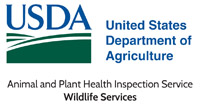United States Department of Agriculture: Animal and Plant Health Inspection Service

United States Department of Agriculture Wildlife Services: Staff Publications
ORCID IDs
Davis http://orcid.org/0000-0002-4962-9753
Gilbert http://orcid.org/0000-0002-8256-0081
Hill http://orcid.org/0000-0003-2761-8786
Document Type
Article
Date of this Version
2024
Citation
Journal of Wildlife Management (2024) 89(2): e22701
doi: 10.1002/jwmg.22701
Abstract
Density estimation for unmarked animals is particularly challenging, yet density estimates are often necessary for effective wildlife management. Raccoons (Procyon lotor) are the primary terrestrial wildlife reservoir for Lyssavirus rabies within the United States. The raccoon rabies variant (RRVV) is actively managed at landscape scales using oral rabies vaccination (ORV) within the eastern United States. To effectively manage RRVV, it is important to know the density of raccoons to appropriately scale the density of ORV baits distributed on the landscape. We compared methods to estimate raccoon densities from camera‐trap data versus more intensive capture‐mark‐recapture (CMR) estimates across 2 land cover types (upland pine and bottomland hardwood) in the southeastern United States during 2019 and 2020. We evaluated the effect of alternative camera configurations and durations of camera trapping on density estimates and used an N‐mixture model to estimate raccoon densities, including covariates on abundance and detection. We further compared different methods of scaling camera‐based counts, with the maximum number of raccoons seen on any given image within a day best explaining density. Camera‐trap density estimates were moderately correlated with CMR estimates (r = 0.56). However, densities from camera‐trap data were more reliable when classifying category of density as an index used to inform management (83% correct when compared to CMR estimates), although the densities in our study fell into the 2 lowest density classes only. Using more cameras reduced bias and uncertainty around density estimates; however, if ≤ 6 camera traps were used at a site, a line transect approach proved less biased than a grid design. Camera trapping should be conducted for at least 3 weeks for more accurate estimates of raccoon population density in our study area (< 5% bias). We show that camera‐trap data can be used to assign raccoon densities to management‐relevant density index bins, but more studies are needed to ensure reliability across a greater range of environmental conditions and raccoon densities.
Included in
Natural Resources and Conservation Commons, Natural Resources Management and Policy Commons, Other Environmental Sciences Commons, Other Veterinary Medicine Commons, Population Biology Commons, Terrestrial and Aquatic Ecology Commons, Veterinary Infectious Diseases Commons, Veterinary Microbiology and Immunobiology Commons, Veterinary Preventive Medicine, Epidemiology, and Public Health Commons, Zoology Commons


Comments
United States government work